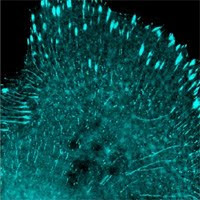RNases are an often feared in molecular biology labs because of their high stability and ominous presence in virtually all living systems. Consequently, people who work with RNA are trained to exercise extreme caution to avoid RNA degradation: change gloves often because human hands ooze RNases; use only sterilized labware as microbes may be sources of RNases; for surfaces that can’t be autoclaved, use sprays like “RNase Zap” (SDS- or guanidine-containing solutions). Such cautionary steps are especially necessary when dealing with low abundance RNA samples.
RNAs can be produced by in vitro transcription (IVT), a simple reaction requiring only a DNA template (double-stranded or even single-stranded DNA as long as the promoter region is double-stranded), RNA polymerase (from T7, SP6, or T3 phage), NTPs, and a reaction buffer that provides appropriate salt and pH. Standard NTPs may be replaced with modified ones to either increase stability or to reduce immune-response when transfected into cultured cells. Additionally, a 5’ cap structure may be added during IVT for further stabilizing mRNAs inside the cells post transfection. Using a commercially assembled kit, one can routinely produce 40-50 µg of mRNA from 1 µg of DNA template in a single 20-50 µl reaction.
At such high concentrations, IVT mRNAs are not nearly as sensitive to RNase-mediated degradation as low-abundance samples. The mRNA can be easily observed on agarose gels that are regularly used for DNA, and their integrity can be monitored after transcription or storage. In most cases one distinct band of mRNA from an IVT reaction is obtained as long as a clean DNA template is used. Preparing a good, uniform IVT template is critical to prevent aberrant products. By using high quality templates, IVT mRNA produced in your own lab are often higher in quality than mRNAs purchased from current commercial sources (Figure in Blog shows mRNAs generated by IVT for R-iPSC). Sometimes there are minor bands created during IVT, but they normally do not interfere with the intended uses of the mRNA, and can be purified away with a purification kit (by using a discriminating purification scheme such as Allele Biotech’s Surface Bind RNA Purification, smaller species can be specifically removed, a separate topic for another blog).
Once produced, mRNAs can be stored at -20C for months, or -80C nearly indefinitely.
http://blog.allelebiotech.com/2012/01/making-transfection-grade-mrna-by-ivt-in-vitro-transcription/
Sunday, January 15, 2012
Subscribe to:
Comments (Atom)




